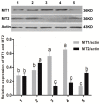Beneficial Effects of Melatonin on the In Vitro Maturation of Sheep Oocytes and Its Relation to Melatonin Receptors
- PMID: 28420163
- PMCID: PMC5412418
- DOI: 10.3390/ijms18040834
Beneficial Effects of Melatonin on the In Vitro Maturation of Sheep Oocytes and Its Relation to Melatonin Receptors
Abstract
(1) Background: The binding sites of melatonin, as a multifunctional molecule, have been identified in human, porcine, and bovine samples. However, the binding sites and mechanisms of melatonin have not been reported in sheep; (2) Methods: Cumulus-oocyte complexes (COCs) were cultured in TCM-199 supplemented with melatonin at concentrations of 0, 10-3, 10-5, 10-7, 10-9, and 10-11 M. Melatonin receptors (MT1 and MT2) were evaluated via immunofluorescence and Western blot. The effects of melatonin on cumulus cell expansion, nuclear maturation, embryo development, and related gene (GDF9, DNMT1, PTX3, HAS2, and EGFR) expression were investigated. The level of cyclic adenosine monophosphate (cAMP) and cyclic guanosine monophosphate (cGMP) were evaluated in oocytes and cumulus, respectively; (3) Results: Both MT1 and MT2 were expressed in oocytes, cumulus cells, and granulosa cells. Melatonin with a concentration of 10-7 M significantly enhanced the rates of nuclear maturation, cumulus cells expansion, cleavage, and blastocyst. Melatonin enhanced the expression of BMP15 in oocytes and of PTX3, HAS2, and EGFR in cumulus cells. Melatonin decreased the cAMP level of oocytes but enhanced the cGMP level in oocytes and cumulus cells; (4) Conclusion: The higher presence of MT1 in GV cumulus cells and the beneficial effects of melatonin indicated that its roles in regulating sheep oocyte maturation may be mediated mainly by the MT1 receptor.
Keywords: MT1/MT2; meioctic maturation; melatonin; oocyte; sheep.
Conflict of interest statement
The authors declare no conflict of interest.
Figures










Similar articles
-
Profile of melatonin and its receptors and synthesizing enzymes in cumulus-oocyte complexes of the developing sheep antral follicle-a potential estradiol-mediated mechanism.Reprod Biol Endocrinol. 2019 Jan 3;17(1):1. doi: 10.1186/s12958-018-0446-7. Reprod Biol Endocrinol. 2019. PMID: 30606208 Free PMC article.
-
Effects of melatonin on in vitro maturation of porcine oocyte and expression of melatonin receptor RNA in cumulus and granulosa cells.J Pineal Res. 2009 Jan;46(1):22-8. doi: 10.1111/j.1600-079X.2008.00602.x. Epub 2008 May 20. J Pineal Res. 2009. PMID: 18494781
-
Evidence of melatonin synthesis in the cumulus oocyte complexes and its role in enhancing oocyte maturation in vitro in cattle.Mol Reprod Dev. 2011 Apr;78(4):250-62. doi: 10.1002/mrd.21295. Epub 2011 Mar 4. Mol Reprod Dev. 2011. PMID: 21381146
-
From Implantation to Birth: Insight into Molecular Melatonin Functions.Int J Mol Sci. 2018 Sep 17;19(9):2802. doi: 10.3390/ijms19092802. Int J Mol Sci. 2018. PMID: 30227688 Free PMC article. Review.
-
Modulation of human ovarian function by melatonin.Front Biosci (Elite Ed). 2021 Jan 1;13(1):140-157. doi: 10.2741/875. Front Biosci (Elite Ed). 2021. PMID: 33048779 Review.
Cited by
-
Melatonin Modulates Lipid Metabolism in Porcine Cumulus-Oocyte Complex via Its Receptors.Front Cell Dev Biol. 2021 Apr 1;9:648209. doi: 10.3389/fcell.2021.648209. eCollection 2021. Front Cell Dev Biol. 2021. PMID: 33869202 Free PMC article.
-
IVM of human immature oocytes for infertility treatment and fertility preservation.Reprod Med Biol. 2023 Jul 11;22(1):e12524. doi: 10.1002/rmb2.12524. eCollection 2023 Jan-Dec. Reprod Med Biol. 2023. PMID: 37441160 Free PMC article. Review.
-
Beneficial Effects of Melatonin in the Ovarian Transport Medium on In Vitro Embryo Production of Iberian Red Deer (Cervus elaphus hispanicus).Animals (Basel). 2020 Apr 27;10(5):763. doi: 10.3390/ani10050763. Animals (Basel). 2020. PMID: 32349425 Free PMC article.
-
Exploring melatonin's multifaceted role in female reproductive health: From follicular development to lactation and its therapeutic potential in obstetric syndromes.J Adv Res. 2025 Apr;70:223-242. doi: 10.1016/j.jare.2024.04.025. Epub 2024 Apr 30. J Adv Res. 2025. PMID: 38692429 Free PMC article. Review.
-
The Uterine Melatonergic Systems of AANAT and Melatonin Membrane Receptor 2 (MT2) Are Essential for Endometrial Receptivity and Early Implantation in Mice.Int J Mol Sci. 2023 Apr 12;24(8):7127. doi: 10.3390/ijms24087127. Int J Mol Sci. 2023. PMID: 37108290 Free PMC article.
References
MeSH terms
Substances
LinkOut - more resources
Full Text Sources
Other Literature Sources
Research Materials
Miscellaneous

